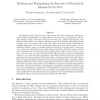Free Online Productivity Tools
i2Speak
i2Symbol
i2OCR
iTex2Img
iWeb2Print
iWeb2Shot
i2Type
iPdf2Split
iPdf2Merge
i2Bopomofo
i2Arabic
i2Style
i2Image
i2PDF
iLatex2Rtf
Sci2ools
ISCI
2008
2008
Modeling and manipulating the structure of hierarchical schemas for the web
The Semantic Web is the next step of the current Web where information will become more machine-understandable to support effective data discovery and integration. Hierarchical schemas, either in the form of tree-like structures (e.g., DTDs, XML schemas), or in the form of hierarchies on a category/subcategory basis (e.g., thematic hierarchies of portal catalogs), play an important role in this task. They are used to enrich semantically the available information. Up to now, hierarchical schemas have been treated rather as sets of individual elements, acting as semantic guides for browsing or querying data. Under that view, queries like "find the part of a portal catalog which is not present in another catalog" can be answered only in a procedural way, specifying which nodes to select and how to get them. For this reason, we argue that hierarchical schemas should be treated as full-fledged objects so as to allow for their manipulation. This work proposes models and operators ...
| Added | 12 Dec 2010 |
| Updated | 12 Dec 2010 |
| Type | Journal |
| Year | 2008 |
| Where | ISCI |
| Authors | Theodore Dalamagas, Alexandra Meliou, Timos K. Sellis |
Comments (0)

